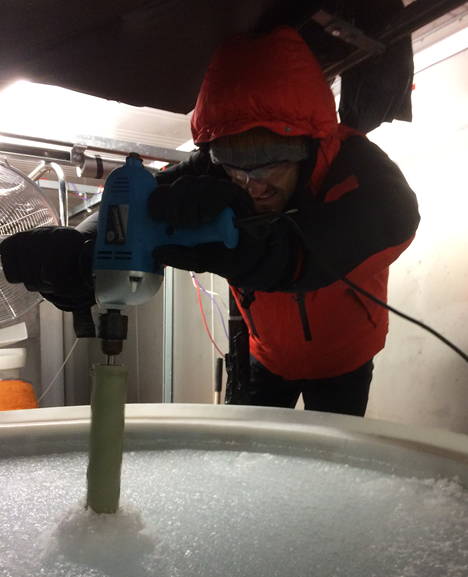Martin King
ECG Bulletin February 2017
ECG committee member Martin King is Professor of Atmospheric and Cryo-spheric Chemistry in the Earth Sciences Department, Royal Holloway, University of London.
ECG committee member Martin King is Professor of Atmospheric and Cryo-spheric Chemistry in the Earth Sciences Department, Royal Holloway, University of London.
|
What inspired you to become a scientist?
During my A-levels studies, I attended a talk at the Cavendish Physics Laboratory in Cambridge by Joe Farnham about ozone hole chemistry. I was the youngest there by at least ten years and what felt like thirty years. The talk was a bit dry for a seventeen year old. But three truths suddenly came clear to me: a few simple chemical reactions could have an enormous effect on the planet, science could be my ticket to some interesting places in the world – including Antarctica – and chemistry was not all about making new compounds, but could be used to explain the natural world. How did you come to specialise in atmospheric and cryospheric chemistry? I wanted to go to Antarctica. My 4th year degree supervisor Professor Richard Wayne studied atmospheric chemistry and ozone. I wondered if this was my ticket, and it was: by applying my love of physical chemistry to the real world. I enjoyed my 4th year research so much that I stayed on to complete a DPhil in Atmospheric/Physical Chemistry, and gave up my other desire to be a fast jet pilot. I carried out post-doctoral work in Fairbanks, Alaska, where I was introduced to the chemistry of snow and ice. I later took up an appointment in London, and subsequently worked in Antarctica with Italian scientists in Terra Nova Bay. |
Could you describe your current job?
I could say that I am a Professor of Atmospheric and Cryospheric Chemistry in the Earth Sciences Department, Royal Holloway, University of London, but that does not help describe what I do. A better question might be: what did you do last week? And I would say that on Monday, I fixed the leaon a two-tonne sea ice tank used for measuring the effect of volcanic ash on planetary albedo. On Tuesday, I was an examiner for a PhD viva (the student passed with flying colours). On Wednesday, I met with three PhDs students to explore the spectroscopy k of ice-bound nitrate, derived the error equation for an optical tweezers experiment, and found a bug in a radiative-transfer programme. I also taught crystal structures of simple silica minerals to first year students and attended a faculty teaching meeting. On Thursday, I completed risk assessments for reacting ozone with organic chemicals from tree leaves to make atmospheric aerosol, worked on a grant application, and attended a plagiarism meeting. On Friday, I taught statistics to third year students and then drove to the Rutherford-Appleton neutron facility to spend three days and nights of the weekend bouncing neutrons off an oily film one molecule thick found at the air-water interface between cloud water and the atmosphere.
What is your advice for anyone considering a career in this area?
The advice I give regularly to students is to not specialise in the environmental aspects too quickly. In my opinion, it is much better to undertake a physics, chemistry, biology or engineering degree and then specialise in environmental aspects later. Whilst this is the route I have taken, and so of course I think it is the best one, I find that nearly every day I am using skills from my core subject applied successfully to environmental problems.
What are some of the challenges facing the environmental science community?
There is a lack of diversity in topics studied, and too much pressure for groups and teams to conform with common ideas. In my opinion, this leads to a lack of diversity of ideas and too much effort spent on one topic, when there are so many other interesting problems that need studying.
What is the most rewarding aspect of your career so far?
Working with PhD students.
If you weren’t a scientist what would you do?
I still think I would have made a great fast jet pilot.
I could say that I am a Professor of Atmospheric and Cryospheric Chemistry in the Earth Sciences Department, Royal Holloway, University of London, but that does not help describe what I do. A better question might be: what did you do last week? And I would say that on Monday, I fixed the leaon a two-tonne sea ice tank used for measuring the effect of volcanic ash on planetary albedo. On Tuesday, I was an examiner for a PhD viva (the student passed with flying colours). On Wednesday, I met with three PhDs students to explore the spectroscopy k of ice-bound nitrate, derived the error equation for an optical tweezers experiment, and found a bug in a radiative-transfer programme. I also taught crystal structures of simple silica minerals to first year students and attended a faculty teaching meeting. On Thursday, I completed risk assessments for reacting ozone with organic chemicals from tree leaves to make atmospheric aerosol, worked on a grant application, and attended a plagiarism meeting. On Friday, I taught statistics to third year students and then drove to the Rutherford-Appleton neutron facility to spend three days and nights of the weekend bouncing neutrons off an oily film one molecule thick found at the air-water interface between cloud water and the atmosphere.
What is your advice for anyone considering a career in this area?
The advice I give regularly to students is to not specialise in the environmental aspects too quickly. In my opinion, it is much better to undertake a physics, chemistry, biology or engineering degree and then specialise in environmental aspects later. Whilst this is the route I have taken, and so of course I think it is the best one, I find that nearly every day I am using skills from my core subject applied successfully to environmental problems.
What are some of the challenges facing the environmental science community?
There is a lack of diversity in topics studied, and too much pressure for groups and teams to conform with common ideas. In my opinion, this leads to a lack of diversity of ideas and too much effort spent on one topic, when there are so many other interesting problems that need studying.
What is the most rewarding aspect of your career so far?
Working with PhD students.
If you weren’t a scientist what would you do?
I still think I would have made a great fast jet pilot.


